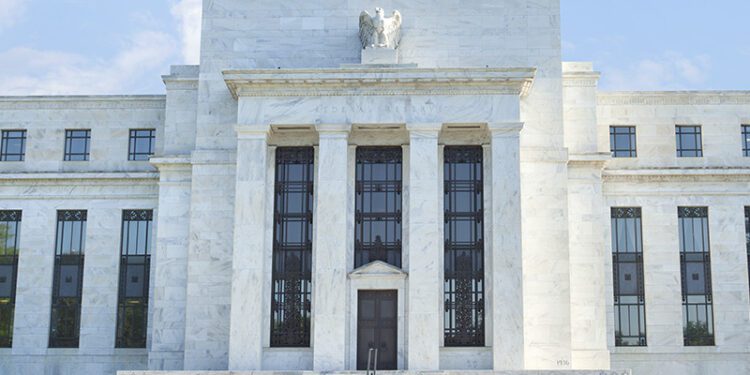2020 – what a year so far! The COVID-19 epidemic is probably the biggest black swan to emerge in recent decades, and the financial market has turned from being overly optimistic (“it’s just a flu”) in early February, to returning to the panic levels last seen in 2008 in mid-March. Viewed as a classic safe haven asset, the price of gold has also been subjected to huge swings. In this article, we are trying to offer more information to help investors assess the potential damage of COVID-19 to the global economy and the outlook of the gold price, both in the short and long term.
What in the Potential Downside on the Gold Price?
Initially many people compared the outbreak of the recent coronavirus to the Severe Acute Respiratory Syndrome (SARS) outbreak in an attempt to foresee how the financial markets will develop. Given that the outbreak of any virus will have a negative impact on social activities and the economy, it is easy to understand why commodities like oil and copper have taken a big hit. Gold price, on the other hand, benefits due to the rise in uncertainties, but is still subjected to massive corrections:
CHART: Gold price performance during SARS period
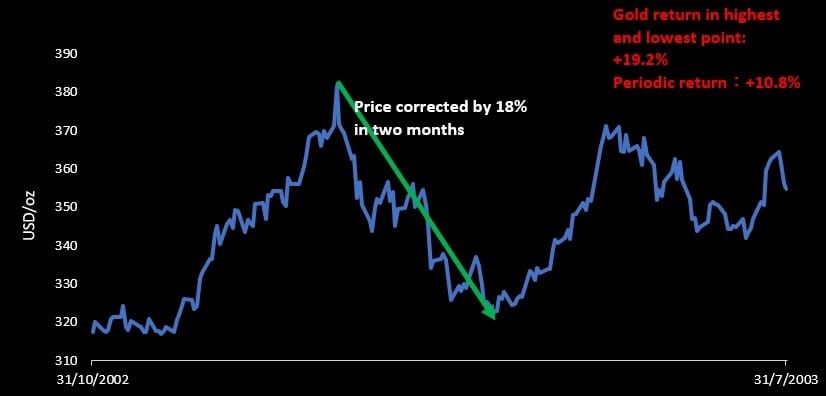
Overall, the gold price increased by close to 11 percent, but it did take some major corrections, including one that took two months to hit the bottom, losing 18 percent from the peak during the process.
However, there are several points that lead us to believe the impact of COVID-19 will be more severe than that of SARS:
- Some of the infected do not show any symptoms yet may still be contagious, and thus people who think they are well may continue their social lives. This vastly increases the spread of the virus.
- 14 days of quarantine may not be enough – there are cases to suggest that the incubation period could last well over 14 days.
- Those who have been cured may continue to be contagious. There are reports from around the world of people who seem to have fully recovered only then to test positive later on. In some cases, patients who recovered and were discharged from hospital after being tested negative twice, were found to be tested positive again within 10-30 days. (We cannot confirm, but we believe that such cases make up at least 15 percent of all confirmed cases in China). This uncertainty makes developing an effective vaccine far more challenging.
Indeed, in terms of the potential damage to the global economy, the 2008 Global Financial Crisis (GFC) may be a more appropriate comparison to the current situation:
CHART: Gold price performance during the GFC:
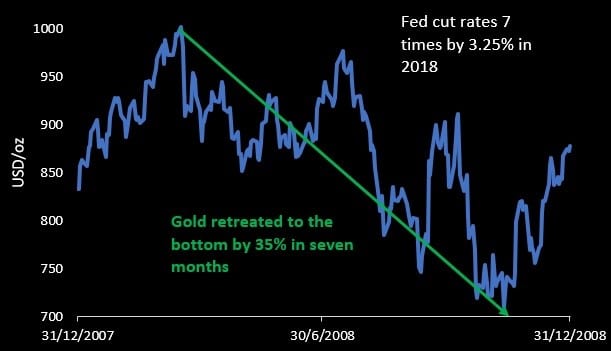
Despite the Fed already cutting interest rates seven times during 2008 (with a total of 3.25 percent being cut), it did not really help save gold from a major price correction, which dove 35 percent from its peak and took seven months to hit the bottom. Therefore if we use the historical correction from SARS and the GFC (18 percent-35 percent), the gold price could possibly hit USD 1,100-1,400 per ounce.
However, during SARS and the GFC, once the major corrections had been made and market sentiment began to stabilize, the gold price hit a sharp rally and a new historical high. We believe this time will be no different, especially since the global central banks have been injecting massive liquidity into the system by historical standards.
CHART: Gold price (orange) pulled off from the US equities (purple) when market sentiment stabilized
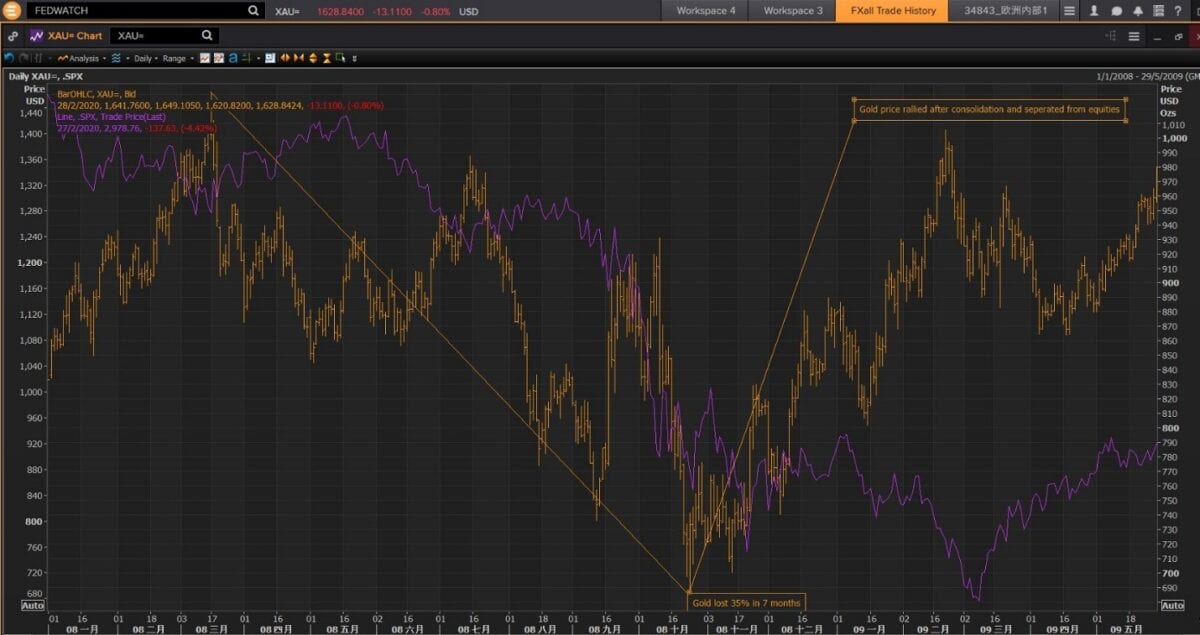
Warning Sign: .Xau Index Lost 7 Percent in One Trading Day
Despite the plunge of the general equities market in February, the gold mining equities sector was relatively strong thanks to the support of the (initial) strong gold price. During the same period of 13-27 February, the gold mining equities index lost just 2 percent, with all the damage done on the 27 February. This saw the index lose 7.0 percent in a single trading day. Such a sharp fall in one day is concerning, especially as the gold price was relatively stable. It also signaled that there is panic in the market as well as increasing demand for liquidity. Both of these factors could possibly drive the gold price lower due to market capitulation, which led us to write our article (published on the 28 February – the day the gold price first took a significant correction starting in the London hours) warning a possible price correction.
CHART: On 27 February, as the gold price (orange) remained relatively flat, the gold equities index (purple) plunged
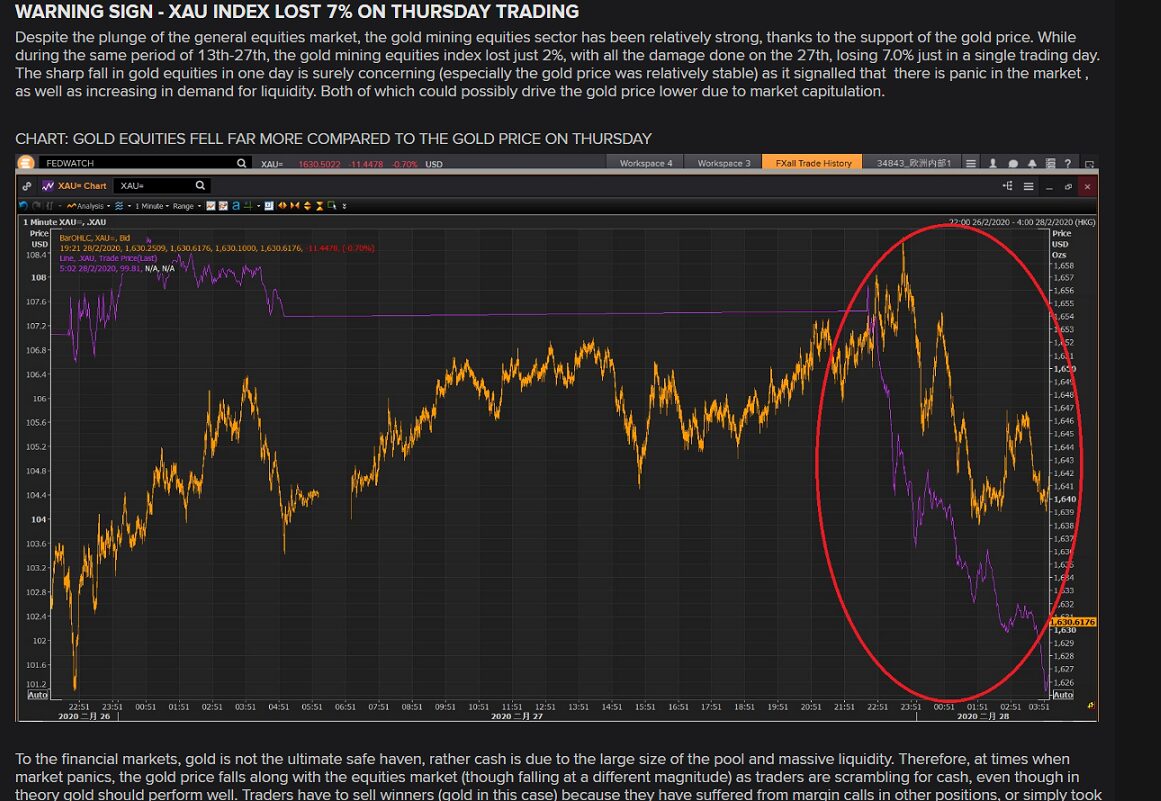
Indeed, the gold equities index has been continuously front running the metals prices and offers a useful (though not entirely efficient) tool to predict how the gold price will perform on a short term basis:
Table: The highlights in red indicate days of stable gold price but significant correction in gold equities, usually signaling further downside in the metal price
| Daily Return | Gold Price | .XAU equity index |
| 13-Mar-20 | -3% | -10% |
| 12-Mar-20 | -4% | -11% |
| 11-Mar-20 | -1% | -8% |
| 10-Mar-20 | -2% | 1% |
| 9-Mar-20 | 0% | -8% |
| 6-Mar-20 | 0% | -2% |
Data Source: Eikon
Why Some Think the Current Rally May Not Last Long
To the financial markets, gold is not the ultimate safe haven; cash is. This is due to the large size of the pool and massive liquidity. Therefore, when the market panics, the gold price falls along with the equities market as traders scramble for cash – even though, in theory, gold should perform well. Traders have to sell winners (gold in this case) because they have suffered from margin calls in other positions, or have simply taken profits to compensate the losses realised in other positions. During a market capitulation, throwing the baby out with bath water is common as traders panic and liquidity tightens.
As of writing, the gold price has rebounded from its low point after the Fed pushed the ‘QE Infinity’, however we would like to warn that it’s not just gold, but an improvement in investment sentiment which has buoyed all asset classes. If one remains weary on the global economic outlook due to COVID-19, then they should remain skeptical and be cautious that this rally may not last long. However, if we have already seen the bottom of the gold price is another question, and really depends on the severity of the epidemic situation, particularly in the US.
Reasons why investors still have to be careful of the rally:
- While China is already ahead of the curve and is recovering from the epidemic, business activities still remain at low levels, and downstream demand remains weak after locals started returning to work after 1.5 months. For example, sales of passenger vehicles in March still fell by an estimated 41 percent year-on-year despite ‘business as usual’. The electric vehicle (EV) sector is in a devastating state as demand is very limited. In a best case scenario, even if the west manages to get the epidemic under control, recovery will take months, and will likely move in a L shape rather than a V shape.
- China is under a possible threat of a second wave outbreak as imported cases spiked. Meanwhile, local people have already lowered their alerts and are re-establishing their social lives. The mass population of some cities classified as low risks have already stopped wearing masks during their interactions.
- The number of confirmed cases in the US have surpassed both China and Italy’s cases. The current situation in the US may reflect that of Wuhan back in January, when the cities had just begun to lock down. This means the situation in the US may be yet to hit rock bottom in terms of the epidemic.
- Despite all the equities and assets being sold off, the investment community will still likely be caught off guard by just how poor financial results will be for the Chinese companies once they began announcing their Q1 results. Their ugly income statements will likely prompt another sell off in global equities, as what happened to Chinese companies in Q1 could happen to the western listing companies in Q2/Q3.
Despite all the cautions and a somewhat pessimistic outlook, gold remains a sure bet for the long run. All the financial aid that central banks provided may not help to solve the epidemic quicker. The central banks can print all the money they want, but as long as people and businesses cut down their interactions and activities, the velocity of money will remain at low levels, resulting in deflation (with the exception of essential goods like food, necessities, and medical supplies). It is my view, that by the time the epidemic is under control, the economy will still be struggling to recover, and when central banks won’t be able to suck up the liquidity they pumped quickly enough, the low but increasing business activities will cause the velocity of money to jump. This will cause either hyperinflation or stagflation scenarios in extreme cases. Therefore, with global central banks injecting liquidity at a level never seen before, it’s a no brainer that gold will surge to historical new highs once the market sentiment has bottomed.
Gold Equities Have Higher Upside in the Longer Run
Just when the gold mining sector began a revision of ratings (as many of their financial statements turned around for 2019), this happened. In the current environment, the gold mining equities sector the metal itself, considering mines are shutting down (for now) as epidemic runs wild, and global production is expected to fall for the full year.
That said, over the next 12 months, once the situation is under control and the gold price is at historical high levels, the current underperformance in gold equities also means there will be massive catch-up to play in the future (ignoring company specific risks). Before the rally following the QE infinitive, the Gold/.Xau equity ratio rose above , a level not seen since 2015 when the gold price also happened to bottom in December that year.

In conclusion, even when the global epidemic is under control, global recovery will be in a L shape, and most of the liquidity that central banks injected will remain within the system (at least initially). At the initial phase of recovery, when economic activities still remain at low levels, gold (and likely gold equities) will pull off from the general equities segment and lead the first asset class to rally à la 2008. While no one can know for sure when both the physical metal and mining equities will hit the bottom, it’s never a bad idea to accumulate through dollar cost averaging.

Author: Samson Li – Senior Precious Metals Analyst, GFMS, Refinitiv
Twitter: @Samsonli7


